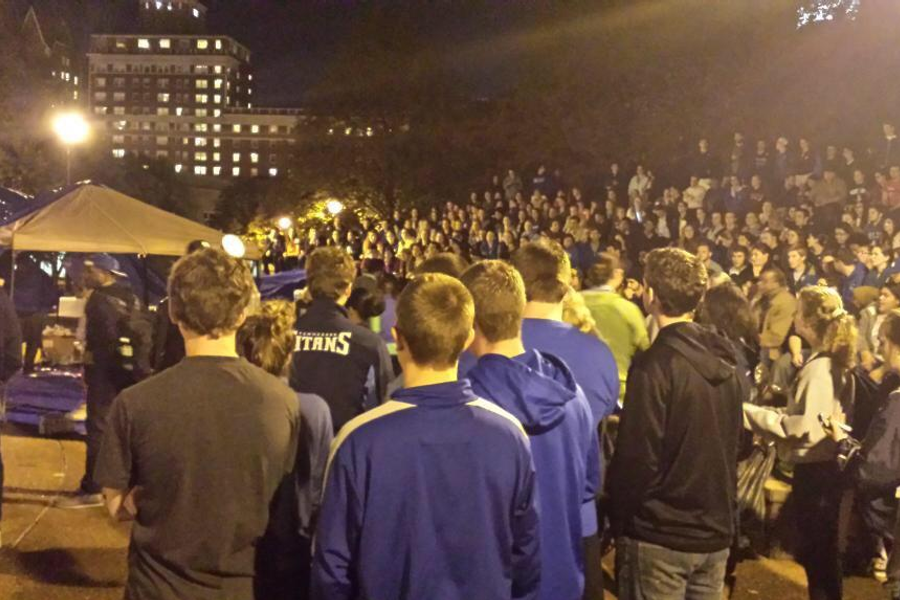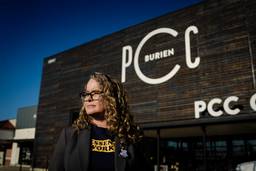St. Louis University Occupation Ends, But Movement for Justice in Ferguson Continues
The spirit of Occupy Wall Street lived on in a weeklong campus occupation demanding justice for Michael Brown.
James Anderson

As the occupation of Saint Louis University (SLU) ended Saturday, October 18, tense discussions ensued.
Seeing the occupation as part of the movement calling for an end to police terror and demanding justice for Michael Brown, the African-American teenager in Ferguson, Missouri, shot and killed by police officer Darren Wilson, occupiers debated questions familiar to Occupy groups around the country at the encampment site on SLU’s campus: Would negotiating an end to the encampment with the administration amount to co-optation? Or would it enable realization of concrete goals like eliminating institutionalized racism by obligating an institution, the university, to change its policies in exchange for clearing out of the space on campus claimed by OccupySLU?
OccupySLU emerged somewhat spontaneously six days before as part of the “Weekend of Resistance” in Ferguson, which was organized a little more than two months after Wilson killed Brown. In the early hours of October 13, Columbus Day, when hundreds of people converged on the SLU campus, the initial aim was not completely clear — for occupiers or onlookers.
What was evident was that the police would not immediately prevent people from marching through the campus. Prior direct actions over the weekend — like the occupation outside a QuikTrip near the corner of Manchester and Vandeventer Avenue in St. Louis where shield- and baton-carrying officers in riot gear quickly arrested 17 people and maced a few more — were, like many of the demonstrations over the past two months, broken up by police.
Brown’s death — and the failure of the police department to arrest and indict the officer who shot him — sparked public outcry and protests starting in August, followed by a now well-documented militarized police response.
Stefan Bradley, director of the African American Studies Program and an associate professor of history at SLU, said Brown’s death “should be viewed as the straw that broke the proverbial camel’s back” after innumerable extrajudicial executions — with little or no legal consequences— of other black men in the US like Oscar Grant, Sean Bell and Eric Garner.
City actions like the removal of a black superintendent in the Ferguson school district without real pretense and “the abject lack of black representation both in the city council of Ferguson and on the police force,” Bradley says via email, are “what provided fuel to the fire that was sparked by Brown’s death and mistreatment.” Public frustration and property destruction were met with military-grade weaponry and force, he added. “The mostly black demonstrators got the sense that the police had a license to kill and that the authorities cared more about property than people.”
Introduction to an Occupation
The move to “occupy,” a term fraught with militaristic connotations, made sense to organizers in the wake of Brown’s death and the militarized law enforcement used to squelch the dissent that followed.
Following an interfaith forum October 12 at SLU’s Chaifetz Arena, part of the planned Ferguson October events, hundreds gathered around midnight in the Shaw neighborhood near where 18-year-old Vonderrit Myers died on October 8 after also being shot by a police officer. Previous marches through St. Louis city streets had started in Shaw after Myers’ death, and the space outside Shaw’s Market corner store became the de facto convergence center for marches like the one that would end at SLU. Princeton professor Cornel West, who spoke during the forum and was arrested during a “Moral Monday” action outside the Ferguson police department the next day, joined the protest along with anti-war activist Medea Benjamin.
During the march, people in the streets shut down the intersection at Manchester and Boyle Avenue in The Grove district of St. Louis after police had set up blockades several streets down. Protesters staged games of “Monkey in the Middle,” jump rope and Twister, while chanting, “They think it’s a joke, they think it’s a game,” providing satirical commentary on police officers’ seeming exemption from punitive actions. When recited in Ferguson, the chants had been directed at police. But during the march, the chants served just as much to articulate a rallying cry, rejecting a world that devalues black lives.
West, Benjamin and about one thousand others later entered the campus of SLU, a private Jesuit institution. After encircling Clock Tower Plaza, a handful of demonstrators opted to occupy at about 3 AM Monday morning, October 13.
Occupiers remained around the clock tower, with 10 to 20 staying overnight each night until Saturday morning, October 18.
Early Monday morning, the day the occupation started, SLU president Fred Pestello sent a campus-wide email explaining that after consulting with St. Louis police and SLU’s Department of Public safety, the university decided “to not escalate the situation with any confrontation, especially since the protest was non-violent.”
Pestello’s office had sent a previous email on Friday, October 10, acknowledging the “police-involved” shooting of Myers, noting the protests occurring near the southern end of SLU campus that week and adding that SLU’s DPS was keeping “in constant contact” with St. Louis police, who were informing SLU of “plans for response to protests,” according to the email.
Despite the administration’s explicit coordination with the police, OccupySLU participants said they were pleased the president visited the encampment. Pestello even voiced concern over a few of the vitriolic responses to the occupation.
“I was disheartened by some of the harsh and ugly words hurled via social media, phone calls and emails that only fueled anxiety, misunderstandings and divisions on all sides at a time when what we needed most was to listen and learn and find common ground,” Pestello wrote in an update to the SLU community the day the occupation ended.
Before occupiers voluntarily took down the encampment, Jamell Spann, 21, who was born and raised in St. Louis but now lives in Ferguson, said part of the rationale for occupying SLU was to bring “the reality of our fight to those people attending college,” and to “exchange intelligent ideas in a productive way.”
Spann, a member of the Tribe X organization involved in the street protest planning and later in the decision to negotiate with the SLU administration, said the day before the occupation ended that the space created around the clock tower could assist in educating young people — a critical necessity, he argued, since college courses “won’t really prepare them for what the real world has in store” regarding police brutality.
Even the antagonism and disruption to the normal flow of campus life became a necessary part of what Tribe X, Millennial Activists United, the Metro St. Louis Coalition for Inclusion and Equity and the SLU students present attempted to create during the six-day stay on campus.
Emma Cunningham, a senior from Cincinnati in her final semester at SLU studying women and gender studies and French, said the first night of the occupation featured a long meeting with facilitated dialogue among several hundred students — many who would continue to visit the occupation and stay late during the six days. People of color recounted interactions they had with the police, and a few people vocalized opposition to the encampment.
“It’s a very privileged campus,” said Cunningham, who was one of the few students, aside from several of the organizers who attend SLU, to stay overnight at the encampment. “A lot of people are ignorant of a lot of real-world issues, especially when it comes to race relations.”
Mainstream news outlets reported on some of the opposition, which Cunningham said had a lot to do with the American flag protesters had hung upside down.
Anonymous participants of OccupySLU addressed the issue in their first and only communiqué, which highlighted the differences in the way black and white people tend to see the world and the flag, as a result of differential police treatment and a close race-class correlation.
Cunningham said she and others at SLU saw the upside down flag as a “symbol of distress.” The day before the occupation ended, she wrote via email that some counter-protesters showed up with signs reading “God Bless America,” “End Occupy SLU” and other similar messages.
Bradley, whose research focuses on young people’s protest movements and black student activism at universities, noted the faculty had “no official policy” regarding the demonstrations, but that many visited the protest site and “cared deeply about the need to create a constructive dialogue” with protesters.
Having interacted with those involved in demonstrations from early on, he suggested the passion of young activists mirrored the fire of activists of the 1960s. However, one “difference between the most involved leaders and participants in those movements of the past was their awareness of world affairs and activist campaigns that preceded them,” he offered. “That is not an indictment of modern activists, but it is an observation that having an awareness of the systems used to diffuse campaigns of the past can only help to sustain present campaigns.”
Ending the Occupation, Starting the Movement
Some occupiers were reluctant to give up the tactic of politicizing space at SLU.
“The encampment for many people became like a home — not just a place of direct action, a place of civil disobedience, but it became a home,” said Jonathan Pulphus, 19, a SLU student and organizer with Tribe X.
Pulphus noted that many people also became personally invested in the occupation, donating resources to sustain it, staying the plaza despite rain, joining in the marches around campus and even helping to block some of the busiest streets in the metropolitan area.
Several occupiers nevertheless deliberated the benefits of approaching the administration with a list of items for institutional change. Many participants held reservations over whether negotiations would end the project prematurely.
A few occupiers, SLU students and the primary organizers, crafted a document with a list of items the institution must address and presented that to the university. The administration provided input on the list of items and agreed to make the changes on the condition that the occupation would end.
A message from the SLU president issued October 22 stated the document that came out of the negotiations “was not, as some have portrayed it, a list of demands.” Rather, “a number of the action items were suggested by me,” the president wrote in the statement.
The document with the agreement contained 13 items.
It called more funding for the African American studies program; improved effort toward retaining black students; creation of a committee to grapple with racial and socioeconomic injustice; creation of a community center; and agreed upon bi-weekly meetings to better advance the university’s mission with regard to community empowerment.
Pestello’s statement stated that several of the items “were already in progress” at the university, and that meetings “to establish timelines and to assign responsibilities for each item” were already underway.
In turn, Pulphus said “part of the agreement was that there had to be something for something,” and he called ending the occupation “a gesture of good faith in the negotiating process.”
With the administration formally agreeing to accept the OccupySLU proposal and implement requested changes over time, all occupiers collectively agreed to leave the plaza that Saturday.
Pulphus said the encampment and Ferguson actions were influenced by Occupy Wall Street, and he averred that the aim is to continue what OWS started while experimenting and broadening the movement’s scope. He said he expects people to hold the “power players accountable” if the university does not follow through with what it has promised, or if the organizations involved do not continue to pressure to ensure goals are met.
“The idea for this movement … is … not to occupy necessarily, but to make sure … the actual ideas of justice and freedom … aren’t just something we say, but something we live,” he said.




